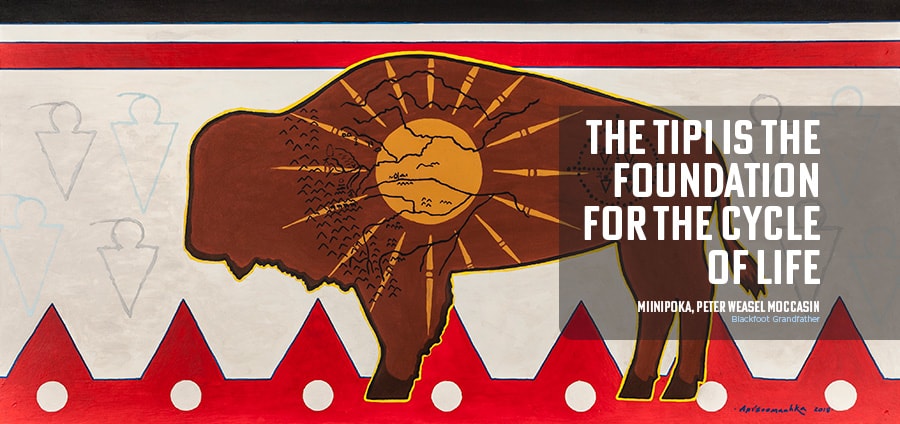
Framework
A framework developed upon Niitsitapi Knowledge Paradigm or Niitsitapiipaitapiiyssin was our foundation as we began the groundwork for meeting our goals of cultural relevance and upholding our commitment to honouring the land and knowledge of the Blackfoot people. The framework arrangement is a tipi ring, a landmark symbol of significant creation by the Blackfoot people. The tipi ring is captured on the Blackfoot Confederacy Flag, designed by Blood Tribe Grandfather Aatso’towa, the late Andy Black Water. The collaborative design of collective thought also included esteemed Blackfoot Grandparents and Knowledge Holders; the flag flies with pride and honour on our college grounds. Through our strategy, we wanted to bring the teaching that tipi rings are spaces on the land that once held a tipi; within the Blackfoot tipi many teachings transpire and transfers of knowledge take place. An important concept to understand is that Indigenous people are not only a people of the past; history is a part of the whole of life that has brought us to today and the transfer of knowledge never ends.
Our Blackfoot Grandfather Miinipoka, Peter Weasel Moccasin, always reminds us that the tipi is the foundation for the cycle of life. Represented within the tipi is an ideal of four stages of life beginning at birth and continuing for one hundred winters and summers; each area of our framework has five stones or representations of tipi poles representing five years.
In planning for engagement, we aligned college departments and centres with strategy themes they more closely represented and could provide thought and expertise on. We included a broader circle of Community Stakeholder groups aligned with each college department and centre. The arrow at the centre points to the west direction, the common seating area of the tipi’s host, Elders and those learning. Around the perimeter is a dotted circle that represents the CICan Indigenous Education Protocols that guide our work and are aligned to each theme; however, the dotted circle denotes that they work holistically together and can easily be applied to other areas around the circle. When a tipi is set, the four largest and strongest poles set the foundational structure; these four poles are placed at the west and east doors. In our framework paradigm, college leadership are at the door symbolizing a commitment to enter the space of learning from the Niitsitapi community, and the Elders who guide us are at the east and the west, both areas where they sit in the tipi guiding those engaged in the learning process.
